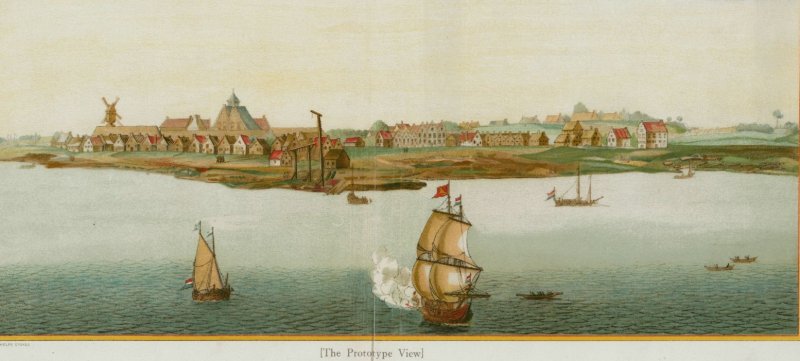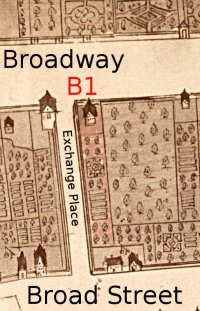
"Prototype View" of New Amsterdam date depicted: c1651 From Phelps Stokes Iconography of Manhattan Island, 1915, Courtesy New York Public Library. Click to enlarge
Houses and gardens in New Amsterdam during the late Dutch period are shown in amazing detail in three images courtesy of the New York Public Library, the Maps Division of the Library of Congress and
Columbia University. They are the "Prototype View", an inset from the Visscher map and the the "Castello plan". The latter, created in 1660 by West India Company surveyor Jacques Cortelyou, shows sketches of the buildings and gardens of every property in New Amsterdam

Inset from the
Visscher map "Novi Belgii", courtesy Map Division, Library of Congress
The 1915 "Iconography of Manhattan Island" by Phelps Stokes is a superb and incredibly detailed 6 volume collection of maps and historical information about Manhattan. Among its treasures in Vol. 2 are the "Castello plan" (so called because the original was and is now stored in a Medici castello in Florence) and detailed historical descriptions of every lot in New Amsterdam as it then existed. The full volume is available from
Columbia University Library, 400 mb, as well as just the lot details
from here (12 mb).
This page provides a
zoomable interface into a copy of the map,
a
key for identification and location of interesting places,
a table listing
all lots and owners keyed to the map and
Stokes'
Lot descriptions (pdf, 12mb)
| Zoomable version of the Castello map
| Key to Castello map
zoomable or jpg (1mb)
|
|

|

|
 "Prototype View" of New Amsterdam date depicted: c1651 From Phelps Stokes Iconography of Manhattan Island, 1915, Courtesy New York Public Library. Click to enlarge
"Prototype View" of New Amsterdam date depicted: c1651 From Phelps Stokes Iconography of Manhattan Island, 1915, Courtesy New York Public Library. Click to enlarge
 "Prototype View" of New Amsterdam date depicted: c1651 From Phelps Stokes Iconography of Manhattan Island, 1915, Courtesy New York Public Library. Click to enlarge
"Prototype View" of New Amsterdam date depicted: c1651 From Phelps Stokes Iconography of Manhattan Island, 1915, Courtesy New York Public Library. Click to enlarge


 The "Prototype View" and the inset in the Visscher map depict the city c1651-1653. Stokes suggest both may be copies of another drawing now lost.
Some of the buildings shown in in the Prototype view of New Amsterdam have crow-stepped gables and red tile roofs and are probably built of brick and stone. In this detail, F5-F9 are warehouses, F10 the old church, O7 the house of captain Adriaen Blommaert and O8 the City Tavern/Town Hall. Van Couwenhoven's house and brewhouse N2 appears to be of wood.
The "Prototype View" and the inset in the Visscher map depict the city c1651-1653. Stokes suggest both may be copies of another drawing now lost.
Some of the buildings shown in in the Prototype view of New Amsterdam have crow-stepped gables and red tile roofs and are probably built of brick and stone. In this detail, F5-F9 are warehouses, F10 the old church, O7 the house of captain Adriaen Blommaert and O8 the City Tavern/Town Hall. Van Couwenhoven's house and brewhouse N2 appears to be of wood. Most houses in New Amsterdam in 1657 were of
wood with roofs thatched with the local reeds and probably had clapboard siding. From the Prototype View and Castello plan most houses appear to have one story with a garret. Almost all buildings have their gable-end facing the street.
The siding shown in the Visscher inset looks to be to be generally horizontal clapboards,
though vertical (board and batten?) siding appears as well. The drawing may not be quite so accurate, since the church inside the fort has the same pattern, but was built of stone.
Most houses in New Amsterdam in 1657 were of
wood with roofs thatched with the local reeds and probably had clapboard siding. From the Prototype View and Castello plan most houses appear to have one story with a garret. Almost all buildings have their gable-end facing the street.
The siding shown in the Visscher inset looks to be to be generally horizontal clapboards,
though vertical (board and batten?) siding appears as well. The drawing may not be quite so accurate, since the church inside the fort has the same pattern, but was built of stone.
 GIS analysis of the
Castello plan gives us an idea of the number and location of houses (253), taverns (20), public buildings (11), military buildings (9) , as well as land use: formal gardens (59), orchards/trees (302) etc.
GIS analysis of the
Castello plan gives us an idea of the number and location of houses (253), taverns (20), public buildings (11), military buildings (9) , as well as land use: formal gardens (59), orchards/trees (302) etc.